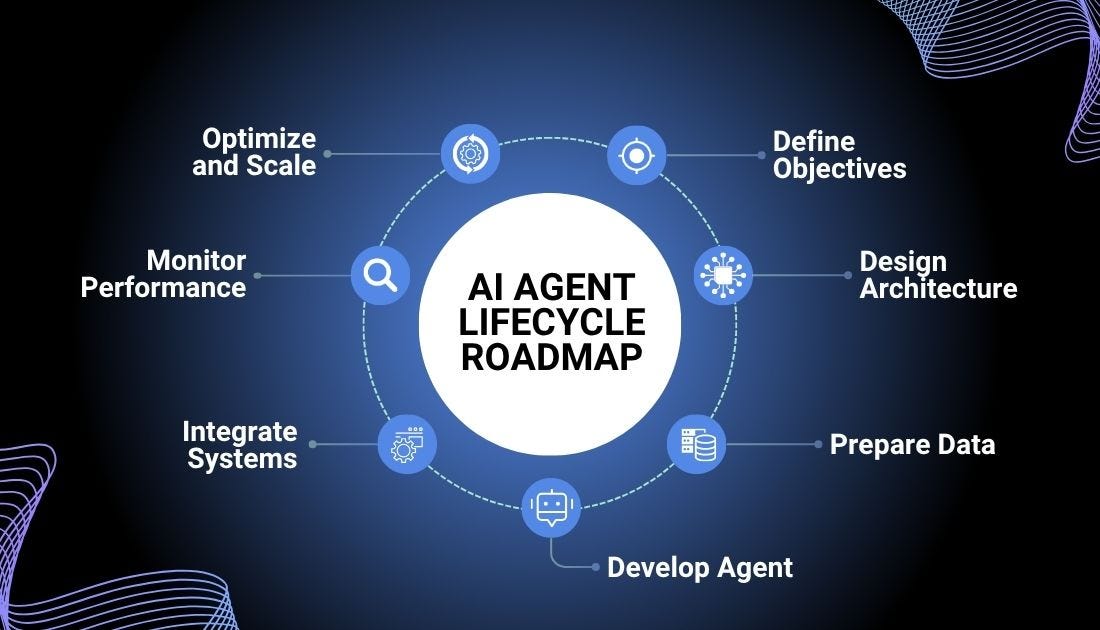5 Critical Steps to Deploying AI Agents at Scale
The AI Agent Gold Rush Is On, But Are You Ready?
Every boardroom I step into these days echoes the same sentiment: "We need AI agents fast."
But here's the kicker: while 82% of companies have already deployed AI agents, only 25% of executives report tangible value from generative AI investments.
Looks like a lot of hype with little payoff.
So what's the problem?
Deploying AI agents isn't just about plugging in a chatbot or automating a task. It's about integrating intelligent systems that can adapt, learn, and drive real business outcomes. And doing it at scale? That's a whole different ballgame.
So, how do you ensure your AI agents don't just add to the noise but become invaluable assets? Let me tell you all about it.
Your AI Agent Deployment Blueprint
1. Start with a Clear Business Objective
Before you even think about technology, ask: What problem am I trying to solve?
Customer Support: Automate FAQs to reduce response times.
Sales: Qualify leads faster and more efficiently.
Operations: Streamline inventory management.
Remember, specificity is your friend. The biggest mistake is trying to build a universal "do everything" agent instead of solving one clear problem extremely well.
2. Choose the Right Architecture
Not all AI agents are created equal.
Depending on your needs:
Rule-Based Agents: Great for predictable tasks.
Machine Learning Agents: Adapt over time, ideal for dynamic environments.
Hybrid Models: Combine the best of both worlds.
Ensure your architecture allows for scalability and flexibility. Modular designs can adapt as your business grows.
3. Data Is Your Fuel—Ensure It's Clean
Poor data quality can cost organizations up to $12.9 million annually. Don't let that be you – ensure this:
Data Quality: Ensure accuracy and consistency.
Data Governance: Implement policies to manage data access and security.
Continuous Updates: Regularly feed your agent fresh data to keep it relevant.
4. Integrate Seamlessly with Existing Systems
Your AI agent should enhance your current operations, not disrupt them.
APIs: Use them to connect your agent with CRM, ERP, and other systems.
User Interfaces: Ensure the agent's outputs are accessible and understandable to end-users.
Feedback Loops: Allow users to provide feedback to continuously improve the agent's performance.
5. Monitor, Measure, and Optimize
Deployment isn't the end—it's just the beginning.
KPIs: Define clear metrics to assess performance.
A/B Testing: Experiment with different approaches to find what works best.
Monitoring Tools: Use dashboards to track agent performance.
Continuous investment is key to ensuring long-term reliability and driving sustained performance.
Common AI Agent Deployment Pitfalls and How to Avoid Them
Overcomplicating the Agent: Start simple. Focus on one task and expand as needed.
Neglecting Security: AI agents can be tricked into exposing data. Implement strict access controls and monitor agent activities.
Ignoring Compliance: Especially in regulated industries, ensure your AI agent adheres to all relevant laws and guidelines.
Lack of Human Oversight: AI agents should augment human capabilities, not replace them entirely. Maintain a human-in-the-loop approach.
Failing to Plan for Scale: What works for 10 users might not work for 10,000. Design with scalability in mind from the outset.
Need a Helping Hand?
Deploying AI agents can be complicated, but you don't have to do it alone.
Sign up for our AI workshop—it's FREE! We'll discuss AI solutions tailored to your industry and present POCs adapted specifically to your business needs.
Let's build the future, one intelligent agent at a time!
See you next time,
Yann




